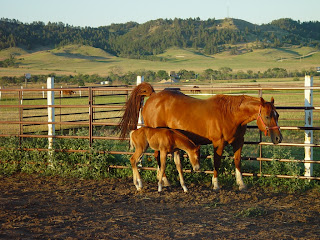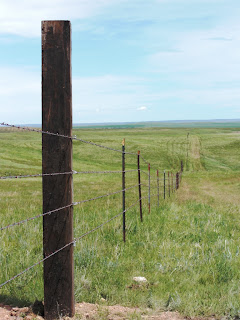by Lee Alley.
Find your Black Hills dream home at Rapid City Search .com
FENCES: Five Mistakes to Avoid in Buying Horse Properties (Part-2)

What's so dag burn difficult about just a "fence," for heaven's sake? Well, if you're a spooked horse next to barbed wire, it could mean serious injury and expensive bills from the vet. If you and your friend are checking out the mare and accidentally touch the electric fence, will his pacemaker survive the lightning jolt? The acreage you bought already had a fence for his cattle, so why not just use it for your horses, too? (No)
The point is, the word "fence" is just too much of a broad, general word in our language. It does not express proper respect for these four key aspects of fences:
- Form
- Function
- Fixups
- Finances.
FORM: You will find several common forms of fence around Black Hills and Rapid City horse properties, including, for example:
- Electric
- Barbed wire
- Non-barbed wire
- Split rail
- Steel pipe.
Each of these and other forms has its own unique installation challenges, purchase costs, skilled labor requirements, and eventually repair and replacement costs. In one of my own acreages where I keep farm animals, this uniquely Black Hills soil is sometimes only six inches deep. It sure keeps the goats entertained while watching me try to coax a Bobcat's hydraulic post-hole auger into solid rock. And you can forget about hand-pounded T-posts. So even the soil type and depth can be an issue in selecting the most suitable form of fence.
This article is not intended to address all the answers; but rather, to alert you to many of the questions before you rush out and make an offer on some "horse property" or a ranchette acreage with the assumption that, "Oh, OK. It's already got a fence. No worries."
FUNCTION: Of course you want to keep your own livestock inside the

fence. But since South Dakota is one of the "fence-out" states you may also need it to keep the adjacent landowner's sheep from over-grazing your pasture (or his emu's from bullying your poor miniature goats).
Fences are also used quite often as a social signal as to who's land stops here and who's land starts there. But the problem is, ( I say this with painful personal
 recall), the boundary is exactly where the surveyor says it is, using laser-beam instruments to interprety lawyer-precise legal description, and not where ol' Shep and his neighbor threw in a fence along the easiest nearby ridge in 1953. So, I'd have to say, "A fence is a device for lulling one landowner into believing he knows where the boundary is, while his neighbor calls the County Register of Deeds, his lawyer, and a surveyor."
recall), the boundary is exactly where the surveyor says it is, using laser-beam instruments to interprety lawyer-precise legal description, and not where ol' Shep and his neighbor threw in a fence along the easiest nearby ridge in 1953. So, I'd have to say, "A fence is a device for lulling one landowner into believing he knows where the boundary is, while his neighbor calls the County Register of Deeds, his lawyer, and a surveyor."
A more dynamic function of fencing is to aid in forage-management. One of the best ways to prevent over grazing is to let the pastures "rest" periodically. That means being able to deploy cross fencing. And gates.
 FIXUPS: A fence is pretty mundane until it gets broken and your favorite pony is found grazing along the highway at midnight. Or when the neighbor's prize 4-H steer waltz's through the tulips in your front yard. It's even less mundane when you take time and materials costs to repair it. You can readily splice wire together, but a broken polyvinyl rail may require replacing an entire section.
FIXUPS: A fence is pretty mundane until it gets broken and your favorite pony is found grazing along the highway at midnight. Or when the neighbor's prize 4-H steer waltz's through the tulips in your front yard. It's even less mundane when you take time and materials costs to repair it. You can readily splice wire together, but a broken polyvinyl rail may require replacing an entire section.
FINANCES: Each form of fence has its own installation "cost-per-foot." A local rancher said to me: "Barbed wire? It's always been a buck-a-foot." Maybe it is that simple. But maybe not in today's dollars. Here are some representative costs of installation (verify these for your area and time frame):
- Electirc -- Less than $1/ft
- Barbed wire -- $1.10/ft
- Split rail -- $3-$4/ft
- Steel pipe -- (whew!).

OK. But how many feet? Well, a square acre is roughly 210 feet on a side, or about 840 feet perimeter for one acre. Due to shared sides, two adjoining square acres would be 1260 feet. A lot of our horse properties here are 10, 20, 40, 80, 160 acres. Here is the perimeter fencing required (but keep in mind, each size has its own demands for added cross fencing):
- 10 acres: 2700 Feet
- 20 acres: 4000 Feet (Typically, two 10-acre parcels side by side)
- 40 acres: 5300 Feet (about a mile)
- 80 acres: 8000 Feet (Typically two 40-acre parcels side by side)
- 160 acres: 10,500 feet.
This is Part-2 of the five part series on buying horse properties. Be sure to catch Part-3, on access, vehicle traffic, and layout.
- Part-1: What Makes a "Horse Property?"
- Part-2: Fences
- Part-3: Access and Vehicle Maneuvering
- Part-4: Location and Siting
- Part-5: Planning

Comments(0)